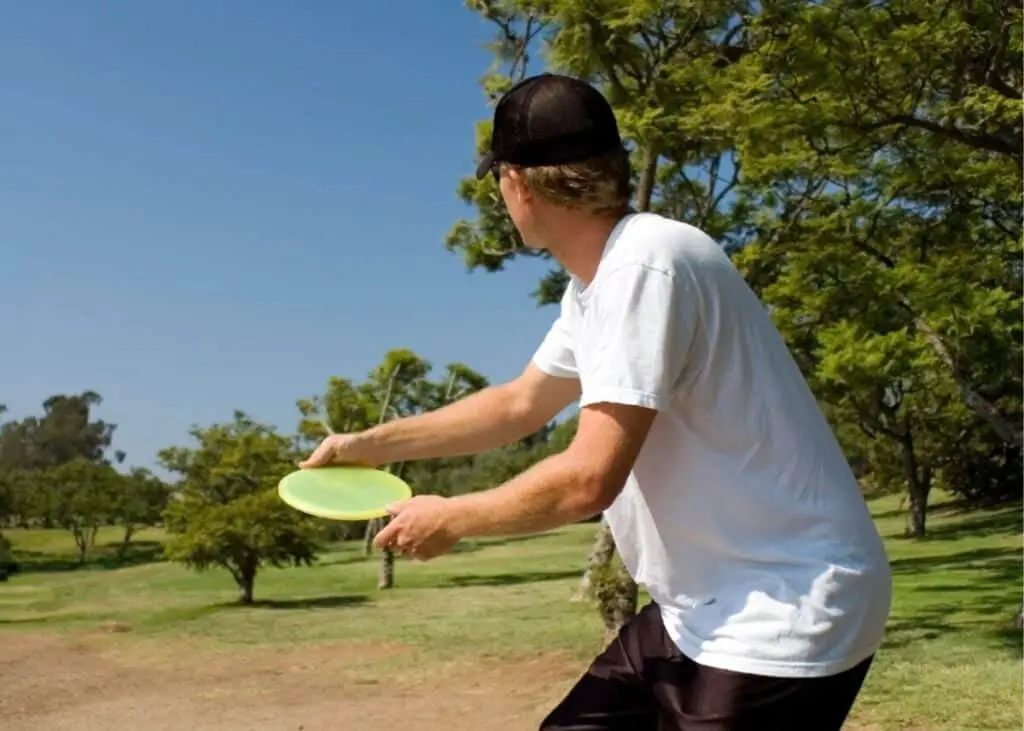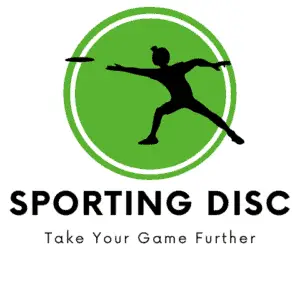Disc golf has its special terminology that can be confusing for beginners. There is no single way to throw a disc. There are a lot of variations a disc golf player might use in certain situations.
In this post, I’ll describe what are the common ways to throw a disc in disc golf and the 7 most common throw variations that are used and how they make the disc perform when thrown.
Table of Contents
Here is What a Throw is Called in Disc Golf
In disc golf, a throw is called a stroke. Each throw is recorded as a stroke on the scorecard. There are three ways a player can throw a disc. A player can throw a disc backhand, forehand, and overhand. Each one of these throws can be released at different angles to create different shots.

What is the Most Common Way to Throw a Disc?
There are three different types of throwing styles that can be used when playing disc golf. These will be the same whether you’re a right-hand or left-hand thrower.
Backhand
A backhand throw is the most common style of throwing that is used a majority of the time by players.
The back-hand throw will generate the most power and will almost always travel the furthest distance when thrown with correct form.
The backhand is thrown using a similar motion as a backhand shot in tennis, with the back of the hand facing the direction you want the disc to travel.
Forehand
The forehand is thrown the opposite way of the backhand. In the forehand throw, the inside and palm are facing the direction you want the disc to travel and the disc is thrown in a sidearm motion.
For most players, the forehand won’t travel as far in the distance as a backhand throw will. Some players will find that a forehand comes more naturally to them if they are used to throwing in a forehand motion already.
Overhand
The overhand throw is the least common of the three. The overhand throw is most similar in motion to throwing a baseball overhand.
The overhead throw will normally only be used as a utility shot in certain situations. The overhand can be useful when you aren’t able to throw around an object and need to go over the top instead.
Disc Golf Release Angles
A player using one of the three throwing methods (backhand, forehand, and overhand) can modify their release angle on the disc to create different flight paths.
Changing the release angle can make the disc perform a certain way in flight to fit the shot or situation on the disc golf course.
Hyzer
No matter if you’re throwing the disc backhand or forehand, the hyzer release angle will always be the same.
A hyzer release angle is when the outside of the disc is angled downward. Releasing the disc with the outside edge angled downward will cause the disc to turn heavily to one side or the other.
It’s a useful shot for getting around an object and savings strokes when on the course.
Anhyzer
The anhyzer release angle is the opposite of the hyzer. Instead of the outer edge of the disc angled downward, the outer edge of the disc will be angled up.
The flight path of the anhyzer for a righthand backhand (RHBH) thrower will start to the right and then turn back to the left. This flight path makes an “S” shape and is a great way to navigate a line around objects like trees.
The anhyzer is also a good way for an RHBH thrower to make the disc fly to the right, instead of the left as the disc typically would when thrown at a flat release angle.
Flat
The flat shot is exactly how it sounds. There is no angle on the release of the disc.
If you need to just throw the disc on a straight line with some accuracy, having the ability to throw with a reliable flat release is a basic skill for disc golf.
Disc choice can make a difference when throwing with a flat release too. An understable and overstable disc can make the shot fade or turn even when throwing flat.
If you want to throw flat and straight, a very stable disc is best using a flat release.
The 7 Most Common Throws in Disc Golf
Every shot below can be made using one of the three throwing methods. Every shot is a modification to the throwing method, usually by altering the release angle of the throw.
As you gain skill and experience in disc golf, each one of these shots can be a tool in your tool belt to get out of a tricky situation on the course and save strokes on your scorecard.
1. Roller
A roller is a shot that does exactly what the name implies. It rolls on the ground using the edge of the disc.
Most beginner players can throw a roller shot, but they probably weren’t doing it on purpose. There is a technique involved in throwing and using the roller shot.
The roller is thrown forehand or backhand low to the ground and on an anhyzer angle.
The roller is a great shot for getting a little more distance with the disc. A more experienced player can throw the disc in the air at an anhyzer angle and make the disc roll straight for extra distance.
2. Flex
The flex shot is very similar to the “S” shot that I talked about earlier when describing the flight pattern of the disc released on an anhyzer angle.
Disc selection is pretty important to throwing a flex shot. You’ll want to choose a disc that wants to fade to the left for an RHBH thrower. This means choosing an overstable disc.
The flex shot when thrown by an RHBH thrower will start to the left, turn to the right and then fade back to the left.
The flex shot is useful for getting more distance while navigating around objects and finishing to the left.
3. Hyzer Flip
A hyzer flip is a modification to the standard hyzer release angle. In addition to the hyzer release angle, the nose of the disc will be angled down slightly.
You’ll want to use an understable disc when throwing a hyzer flip and only throw with about 50% power. At this point, the disc will flip up flat and turn before fading at the end.
A hyzer flip is a great shot for getting extra distance on your throw.
4. Tomahawk/Thumber
A tomahawk or a thumber are both shots using the overhand throw. The only difference is the way the disc is held.
The tomahawk shot uses your fingers on the inside of the disc, whereas the thumber uses your thumb on the inside of the disc.
The tomahawk will pan to the right and finish to the left. The thumber will pan to the left and finish to the right. This is with a right-hand thrower.
These throws are great when you need to go up and over a tall object and there is no way around.
5. Turnover
The turnover is an anhyzer release shot that will turn to the right for an RHBH thrower. It’s especially useful for getting around corners that turn hard to the right.
The focus for a good turnover shot is to release on an anhyzer angle without the front nose pointed up, but rather level or down a little.
6. Spike Hyzer
The spike hyzer is another option for going over tall objects without throwing them overhand. A spike hyzer is useful because when it lands it will dig rather than roll on the ground.
Throwing on a hyzer angle, the focus will be to lower your arm down to get a lot of air under the disc.
7. Scooby
The scooby is another up-and-over shot that can be used much like a tomahawk or a thumber. In a way, it’s a combination of the hyzer flip and a thumber.
One difference is that your thumb will now be on the inside of the rim instead of the outside like with a thumber.
Then, you throw the scooby on an extreme hyzer angle. Your arm will be very low to get lots of air under the disc.
The object with the scooby shot is to throw the disc as high as possible to get it over whatever tall object is blocking the path.
Summary | What is a Throw Called in Disc Golf?
A throw can mean many things in disc golf. There is a throw as a broad term that is just a stroke counted on a scorecard.
A throw is also the way that you throw the disc, like the backhand, forehand, and overhand. Finally, using different release angles and throwing motions you can throw different shots to make the disc take a certain flight path.
